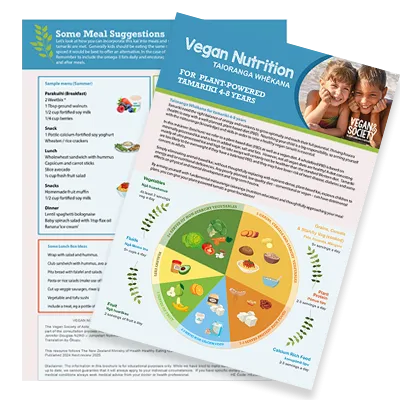Tamariki need the right balance of energy and nutrients to grow optimally and reach their full potential. Thriving hauora (health) is easy with a well-planned, plant-based diet (PBD). Nourishing your child is a big responsibility, so arming yourself with the mātauranga (knowledge) and skills in order to raise a healthy vegan tamaiti is essential.
In this mātārere (brochure) we refer to a plant-based diet (PBD) as well as a vegan diet. A wholefood PBD is based on minimally processed kai and is low in added sugar, salt and fats. However, not all vegan diets are healthy! A diet consisting mainly of ultra processed kai and high fat take aways will certainly not be healthier than the standard Western diet. Tamariki are less likely to be overweight if they have a balanced PBD, and they may have lower risk of heart disease, diabetes and some cancers as adults.
Simply eliminating animal-based kai, without thoughtfully replacing with nutrient-dense, plant-based kai, exposes children to energy and/or nutritional deficiencies. Any poorly-planned, low quality diet – conventional or vegan – can have detrimental effects on physical and mental development and long-term hauora.
By arming yourself with fundamental mātauranga taioranga (nutrition education) and thoughtfully approaching your meal plans, you can give your plant-powered tamaiti a great foundation!
Vegetables - Ngā huawhenua
At least 3 servings veg a day
Fluids - Ngā Momo Inu
<5 cups a day
Fruit - Ngā huarākau
2 servings of fruit a day
Grains, Cereals & Starchy Veg (cooked) - Pata, Huapata, Māngaro
5 servings a day
Plant Protein - Pūmua tipu
2-3 servings a day
Calcium Rich Food - Konupūmā tipu
2-3 servings a day
Key points when planning a vegan diet for tamariki
Variety
Variety is the cornerstone of a well-formulated Plant Based Diet (PBD).The emphasis should be on minimally processed kai from all kai groups. Make sure you eat enough kai from each of the food groups/ngā whakarōpūtanga kai.
Energy Needs
Ensure energy needs are met. Whole grains, legumes, vegetables and fruit, which form the bulk of the PBD, are high in vitamins, minerals and fibre but have low energy density. This is ideal for adults who can manage a large volume of kai.
Tamariki have smaller stomachs and may be full before their energy needs are met. We suggest offering them kai with higher energy density such as home baking, dairy-free yoghurt and ice creams and including some high fat foods (drizzle of olive oil, avocado and nut butters).
The best way to judge whether energy needs are met is to monitor tamariki growth rate on individual growth charts. Your GP should be keeping a close eye on this.
Aim for 2 pieces of fruit daily for fibre and vitamins. For younger tamariki fruit can be peeled and cut up. Drink fruit juice in moderation – āta inumia – as it is high in sugar.
Iron
Vegan tamariki may be at risk of low iron due to lower bioavailability from some plant-based kai. However, this can be met by the staples of a whole food plant- based diet, including legumes, whole grains, dark and green leafy vegetables. Many breakfast cereals are iron fortified, however, choose one with little added sugar.
Iron absorption in meals is improved by adding a vitamin C rich vegetable or fruit at every meal. Iron enriched cereals can also help increase intake. Calcium and iron can compete for absorption, so it is useful to offer alternative milks in-between meals rather than with meals containing iron foods, such as plant-based proteins.
If your tamaiti appears to be pale or listless and lacking in energy, ask a GP to check their iron levels. Iron deficiency will require iron supplementation prescribed by a GP or dietitian.
Healthy Fats
Include some healthy fats to provide extra energy, including avocado, nuts, nut butters, and olive oil but minimise fried foods.
Omega-3 fats are essential for brain development. Include at least one serving a day. Good sources are ground flaxseeds, chia seeds, walnuts and canola oil. These can be added to baking, cereals and smoothies.
In a nutshell
Vegans may be at risk of low iodine intake – especially as NZ soils are low in iodine. Iodine is critically important for children’s growth and development. The daily requirement for a child 4-8 years is 90mcg/day. This can be met by 2 slices commercial bread and 1⁄4 t (1.5g) iodised salt. Note rock salt and pink Himalayan salt are typically not fortified. Always use salt sparingly.
Supplementation with vitamin B12 is essential – aim for 25-50 mcg vitamin B12/day. Vitamin B12 should be given separately, rather than relying on a multivitamin.
The vegan diet is low in vitamin D. Hence vegans need to rely on vitamin D formed when skin is exposed to sunlight. Dark skinned children and children with low sun exposure (eg during winter / spring in the colder climates) are at risk of low vitamin D levels. Discuss with your health care provider whether a supplement is needed.
Other supplements: A well-balanced vegan diet should meet your child’s need for protein, vitamins and minerals (not mentioned above). If you have concerns re the adequacy of your child’s diet, we recommend seeking support of a vegan friendly dietitian. While a well formulated kids’ multivitamin and mineral supplement may be beneficial in some circumstances, supplementing with individual vitamins / minerals should only be done under professional advice. Most importantly supplements should never be relied upon to prop up a poor diet.
The ideal is to eat a largely wholefood, minimally processed diet comprising grains, legumes, nuts, huawhenua (vegetables) and huarākau (fruit). However, let’s face it, we all need a break from cooking sometimes. So it’s OK to include some commercial vegan kai such as vegan sausages and treats for taste and convenience. Some are healthier than others, so do check the ingredients!
Keep an eye on the fluid intake of your tamaiti to ensure they are well hydrated.
Encourage them to drink plenty of wai.
Monitor energy levels, weight and growth to ensure your kids stay on track.
If you notice any changes seek expert advice sooner rather than later.
Putting it all together
The following guide can be used to plan the type and amount of kai for your tamaiti.
healthy growth and development
Include at least 2-3 servings of protein-rich kai daily for healthy growth and development.
- 1⁄2 cup cooked beans / lentils
- 1⁄4 cup peeled edamame (green soybeans)
- 60g firm tofu
- 1 tablespoon peanut butter
- 30g nuts (ground for younger tamariki)
- 1 veggie sausage
- 1⁄4 cup hummus
abundant energy and healthy gut
For abundant energy and a healthy gut include grains / cereals / starchy veg at meals and snacks. Older and more active tamariki will need larger serves.
- Whole grain cereals eg 2 weetbix, 1⁄2 -1 cup porridge
- 1 slice wholemeal parāoa (bread), parāoa roll or wrap
- 1⁄2 cup cooked grains eg brown rice, quinoa, pasta
- Tortilla, tacos
- 1 small rīwai (potato) or piece of kūmara or 1 corn cob
- Home baked muffins and slices (lower in sugar than commercial)
- Wholegrain or rice crackers
strong bones and teeth
For strong bones and teeth include 2-3 servings of kai rich in calcium:
- 1 cup fortified plant-based milk with 100mg calcium/100ml)
(Note rice milk and almond milk are low in protein and energy. Soy milk is a better option for growing children.) - 60g firm tofu
- 1 pottle calcium fortified yoghurt or ice cream
- Other foods such as leafy greens (e.g. broccoli, kale, bok choy), oranges, almonds, legumes, tahini and seeds also contribute small amounts of calcium
Most commercial vegan “cheese” is high in fat and lacking in protein and calcium
health and immunity
Include vegetables and fruit for overall hauora (health) and strong immunity – aim for 3 serves vegetables and 2 serves fruit daily.
- Aim for a rainbow on the plate including dark green leafy, red and dark orange huawhenua (vegetables). Include some raw veggies/fruits in the lunch box.
- You can also add veg to smoothies, muffins, pasta sauces and stews.
- Add a drizzle of olive oil to improve uptake of beta carotene (for vitamin A).
- Serve raw veg dipped in hummus or nut butters.
Note: Popcorn, whole nuts and peanuts are unsafe for younger children due to choking risk.
Grapes, cherry tomatoes and hot dogs should be cut up.
Other considerations
Unsure whether you are on the right track? Does your child have special needs or allergies? Or are they fussy eaters who refuse the tasty meals you have lovingly prepared? Like all parents, you want to know you’re giving your tamaiti the best possible start in life and sometimes it can feel overwhelming. Don’t hesitate to reach out if you need help. Your GP can refer you to a Registered Dietitian or contact the Vegan Society for recommendations for vegan-friendly dietitians.
Some Meal Suggestions
Let’s look at how you can incorporate this kai into meals and snacks to ensure the taioranga and kai needs of your tamariki are met. Generally kids should be eating the same meals as the rest of the family. If your meals are highly spiced it would be best to offer an alternative. In the case of younger children food can be cut up into smaller pieces. Remember to include the omega-3 fats daily and encourage drinks, preferably water, regularly throughout the day and after meals.
Sample menu (Summer)
Parakuihi (Breakfast)
2 Weetbix ®
1 Tbsp ground walnuts
1⁄2 cup fortified soy milk
1⁄4 cup berries
Snack
1 Pottle calcium-fortified soy yoghurt
Wheaten / rice crackers
Lunch
Wholewheat sandwich with hummus
Capsicum and carrot sticks
Slice avocado
1⁄2 cup fresh fruit salad
Snacks
Homemade fruit muffin
1⁄2 cup fortified soy milk
Dinner
Lentil spaghetti bolognaise
Baby spinach salad with 1tsp flax oil
Banana ‘ice cream’
Sample menu (Winter)
Parakuihi (Breakfast)
1 cup oats
1 Tbsp flax meal
1/2 cup fortified soy milk,
1 kiwifruit – sliced
Snack
2 Corn thins
1 Tbsp peanut butter
1⁄2 banana
Lunch
1 bowl lentil and vegetable soup
2 slices bread with vegan spread
1⁄2 orange cut in wedges
Snacks
Hot chocolate (made with soy milk)
Home made oat & walnut cookie
Dinner
Stir-fried sweet and sour tofu, vegetables with noodles
Chia pudding with berry sauce
Some Lunch Box Ideas
Wrap with salad and hummus.
Club sandwich with hummus, avo and baby spinach
Pita bread with falafel and salads
Pasta or rice salads (make use of leftovers). Add lentils / chickpeas for protein.
Cut up veggie sausages, rīwai (potato) salad and cherry tomatoes
Vegetable and tofu sushi
Include a treat, eg a pottle of soy yoghurt, small muffin
Vegan nutrition for tamariki 4-8 years,
Written by Sandra van Lill (Accredited Practising Dietitian)
The Vegan Society of Aotearoa would like to thank the contributors and the many individuals and groups who gave feedback as part of the consultation process that helped shape this flyer; Doctors For Nutrition, Anna Sloan NZRD – Nutrition Connection, Jennifer Douglas NZRD – Jumpstart Nutrition, Dr. Amanda Benham PhD, APD, FASLM – PB Nutrition
Translation by Ōkupu.
This resource follows The New Zealand Ministry of Health Healthy Eating Guidelines for New Zealand Babies and Toddlers 2021.
Published 2024 Next review 2025
Disclaimer: The information in this brochure is for educational purposes only. While we have tried to make sure it is accurate and up to date, we cannot guarantee that it will always apply to your individual circumstances. If you have specific dietary concerns or medical conditions always seek medical advice from your doctor or health professional.















